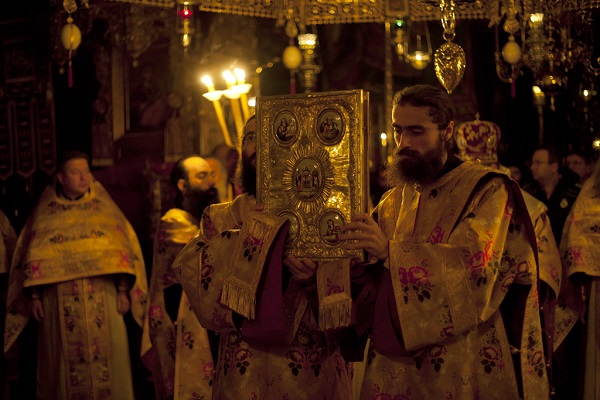The Small Entrance
28 February 2022In every Divine Liturgy, following the Antiphons, the Holy Gospel makes its way from the Holy Table (where it is found at all times), and is carried through the center of the Church, being then returned to its place. The Holy Gospel symbolizes our Lord Jesus Christ Himself, and is displayed in procession, passing through the faithful in a holy entrance on its way to the Sacred Altar once more.
This entrance helps us to understand the coming of Christ into the world, with the Holy Gospel symbolizing Christ. The priest, after venerating the Holy Gospel gives it to the Deacon (if there is one), who then holds the Gospel at the height of his face (covering it). This is done to symbolize the coming of Christ with the Gospel. The candle represents St. John the Baptist, as the Evangelist John says: “He was a burning and shining light “ (John 5:35). He was the one who opened the way for Christ’s coming, and so the whole Church welcomes the Holy Gospel, reminded of His entrance into the history of the world, bringing the possibility of our union with the God-man Christ in His Church.

When the Priest comes to the middle of the church, he fervently prays: “grant that holy angels may enter with us”. There can be no doubt that this true, for where Christ appears, He is surrounded by a multitude of His Angels. This is especially so in the Divine Liturgy, where Christ Himself offers the Mystery of the Eucharist. St. Spyridon was not the only one who saw holy angels assisting him, for there are other recorded instances of this happening. This is the reason why hymns of angels known from the Bible are included in the Divine Liturgy and sung (which will be, God willing, discussed in future homilies). With joy we sing: “Let the heavens be glad, and let the earth rejoice! ⁄ Today the Good Shepherd of angels and men has come.” (Theotokion of the Vespers of 30th of December). Indeed, we realize how high the Lord has raised us and how much He values us.
After the “Entrance Prayer,” the Priest blesses the Entrance of the Clergy into the Holy Altar. And then the Deacon, raising the Holy Gospel so that everyone can see it, exclaims: “Wisdom! Arise!“. The Holy Gospel is Wisdom and Wisdom is Christ, as the Apostle Paul writes: “Christ [is] the power of God and the wisdom of God” (1 Corinthians 1:24). All of us, both physically as well as spiritually (with readiness and vigilance), behold the Holy Gospel. It is just as in the cities and villages of Galilee and Judea when Christ appeared. The Holy Evangelists speak further on this: The Lord went to a deserted place to pray, and “when the multitudes heard it, they followed Him on foot from the cities“ (Matthew 14:13). We also feel that we have Christ Himself among us, when we look upon the Holy Gospel. That is why all believers spontaneously bow reverently together to the Holy Gospel, making the sign of the cross and strengthening each other with the chanting of “Come, let us worship and bow down before Christ”. Immediately afterwards, addressing Christ, we sing: “Save us, O Son of God…” How many people who faithfully prayed the words “save me” (or “have mercy on me”) to Jesus were actually saved by the miraculous intervention of the Lord! Who should I mention first? The Twelve Disciples who were in danger of drowning in the storm in Tiberias for example. They cried out to the Lord: “Lord save us!” At the command of the Lord, immediately “there was a great calm” (see Matthew 8: 23-26). The Holy Gospels and the History of our Church are full of similar miracles with which the Lord responds to those who call to Him this way in faith.
The Entrance of the Lord – in the form of the Holy Gospel’s procession to the Holy Altar of the Church symbolizes the coming of the Son and Word of God to the world. He comes as an infallible Teacher, which Jesus Himself affirmed: “I am the way, the truth, and the life” (John 14:6). His Disciples proclaimed the following: “You have the words of eternal life. We have come to believe and to know that you are the Christ, the Son of the living God.” (John 6: 68-69). There is also the testimony of Jesus’ enemies. When guards were sent to arrest Jesus while he was preaching, they marveled at the words of the Lord, and forgot the command they had received! “No man ever spoke like this Man.”(John 7: 45-46).
So this Jesus Christ, the only true Teacher, is seen at the Entry of the Holy Gospel. In this first part of the Divine Liturgy, until the prayers for the Catechumens, the emphasis is on the priesthood of the Word of God. Just as the Lord first appeared to the world and proclaimed His Gospel, and then surrendered Himself to the dishonor of crucifixion, so it is in the Divine Liturgy. He is first proclaimed as the Teacher and Priest of the Gospel, and then as a Priest of the sacrifice of His Holy Body and Blood. The order of the Divine Liturgy follows His earthly life.






